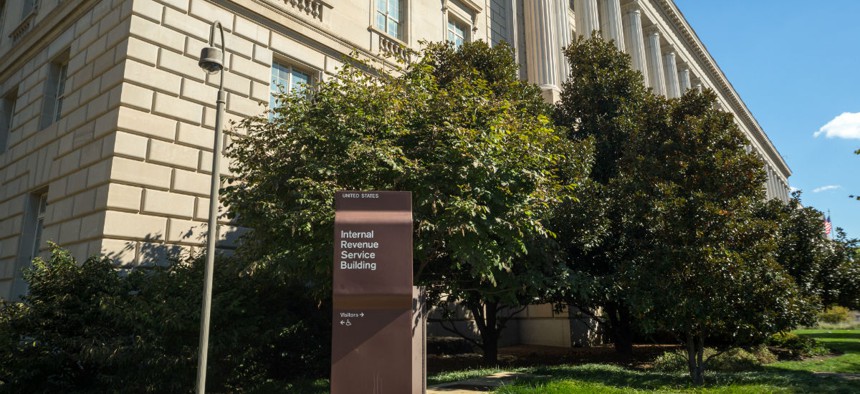
By blvdone / Shutterstock.com
Taxpayer Advocate Details Shutdown's Impact in Her Final Report
Retiring Nina Olson cites harm to customer service as well as staff training.
In her final mandatory twice-annual report to Congress as she retires after 18 years, National Taxpayer Advocate Nina Olson focused on the impact of last winter’s record-breaking 35-day partial government shutdown on taxpayers, the Internal Revenue Service and her own staff.
The report also reviewed IRS performance during the 2019 filing season, repeated earlier proposals for reforms—such as creating a “road map of tax controversies” to improve taxpayer understanding of the system—and criticized the Trump administration’s proposal to cut the taxpayer services budget.
During the shutdown from Dec. 22-Jan. 21, “taxpayers had limited means to obtain customer service assistance from the IRS via phone, in person, or by mail,” the report said. “During this time, it is estimated that there were 3.8 million attempts to call the IRS. The IRS canceled 16,530 scheduled appointments” at Taxpayer Assistance Centers due to furloughs, estimating later that it received more than 5 million pieces of taxpayer correspondence during the shutdown.
In addition, “delays occurred in the hiring and training of customer service personnel,” specifically “a five-week delay in training for 2,502 of the 2,903 new [representatives] hired to answer tax account calls and resolve tax account issues,” Olson wrote. “The IRS was able to complete training for only 436 of the new hires prior to the President’s Day peak period, leaving 2,066 new [customer service representatives] who were unable to answer taxpayer calls. This contributed to a 57% [level of service] as of Feb. 22, 2019, compared to a 78% [level] reported at the same period in the prior year.”
Even so, staff were able to begin processing returns just three days after the government reopened on Jan. 25, Olson wrote, and “on that first day, the IRS processed more than 1.9 million e-filed returns during its peak hour—setting a new record with a rate of 536 submissions per second.”
Also harmed by the appropriations lapse were the IRS’s Low-Income Taxpayer Clinics, the report said, because the administrator couldn’t disburse January funds until February, “thus putting clinicians at risk for layoffs or leading to the possible delay of the start of new clinic operations. It also led to the delay in opening the solicitation of supplemental funding applications for states without [a clinic], which will likely limit start-up activities by new grantees due to later announcement, processing and disbursement of funds,” the report said.
Taxpayer Advocate Service staff within weeks of reopening saw a nearly 10% rise in taxpayer complaints and identified 165 “emergency” cases requiring immediate attention because taxpayers “experienced significant economic or irreparable harm during the shutdown,” Olson noted. “It is vitally important for TAS to capture the impact of the shutdown on taxpayers so we can include this information in our many discussions with Congress and the IRS as part of our advocacy and collaborative improvement efforts.”
The shutdown also negatively impacted hiring plans in the taxpayer advocate’s office. Before the furloughs, it had planned to hire and begin training 110 case advocates and expand intake advocate hiring in advance of the 2019 filing season. “While TAS met the hiring goal for one of those employee positions, the continuing resolutions resulted in neither group of new hires receiving training prior to the start of the shutdown,” the report said. “This lack of training prevented them from assisting with taxpayer cases or calls when the IRS reopened.”
Improving customer service for low-income Americans remains high on Olson’s priority list. “Even as the system works for most taxpayers most of the time, it doesn’t work for millions of others,” she said. “Taxpayer service is woefully inadequate. . . . IRS audit notices are often unclear, leading some taxpayers to ‘agree’ to assessments by default – even when they don’t owe the tax. And the IRS doesn’t screen for ability to pay before it takes collection actions, thereby causing or worsening financial hardships for financially vulnerable taxpayers.”
Despite the shutdown, the IRS’s handling of filing season was a mixed success. The IRS received about 137 million individual income tax returns and issued about 96 million refunds. About 92% of returns were filed electronically, and about 87% of taxpayers who received refunds elected to receive them via direct deposit. “These statistics are comparable to the prior year,” Olson wrote.
However, from Jan. 1-April 20, IRS received 40.8 million phone calls, but achieved a 67% level of service, down from 80% last year. IRS telephone assistors answered just 25% of taxpayer calls enterprise-wide, and hold times for taxpayers who got through averaged 13 minutes, the report said. Despite the President’s Management Agenda’s goal of improving customer service, the IRS “performs poorly relative to” private sector groups and other federal agencies. At the same time, Olson criticized the Trump administration’s fiscal 2020 budget for requesting a cut of 6.6% in taxpayer services, even though it sought a 5% hike for enforcement.







